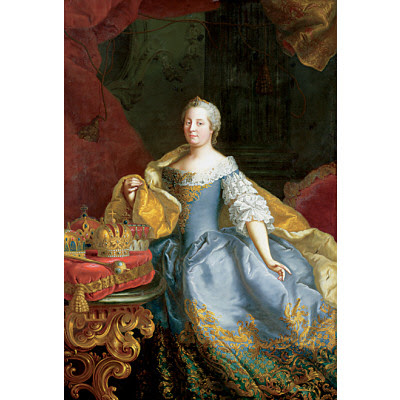
A portrait of the Empress Maria-Theresa of Austria, c. 1745/1750, by Martin van Meytens II (Swedish, 1695-1770, active in Vienna), round about the time she founded the Hofmobiliendepot. The painting is in the collection of the Ringling Museum of Art in Florida.
The Hapsburgs had many palaces and hunting lodges that were continually updated to reflect the latest fashions, and the incredible foresight of the Empress, which has been continued since her death in 1780, has resulted in a collection of some 160,000 objects, ranging from every-day items used by the court, to the thrones from which the family ruled.
The depository, shown prior to their recent renovation, illustrates the old fashioned, and rather charming, means of storing objects, so different from the scientifically-monitored vaults of today:


The Hofmobiliendepot provides a unique study of a family, Austria's imperial history, and nearly 300 years of Viennese cabinet-making and period decoration. To represent the post-imperial commissions that have continued to define Austrian taste over the last century, the collection also includes works by 20th century architects and designers including Otto Wagner, Josef Hoffmann and Ernst Plischke.
The museum, which relocated to a renovated-warehouse complex in 1998, is a very modern structure, which makes an interesting juxtaposition to the historical nature of the collections. It also provides an ideal venue for small take-shows, especially those focused on modern design.
The Hofmobiliendepot's Modernist inner courtyard (below) and Hoffmannesque entrance hall (bottom):


The current exhibition, Italian Design 1945-2000, features 100 objects from the permanent collection at Milan's Triennial and is primarily focused on five defined periods of Italy's design history: the post-war years (1945-1960); the plastics boom of the 1960s; the social unrest of the 1970s; 80s Postmodernism; and the search for a new identity in the 1990s.

The Pratone chair, 1966
Gruppo Strum's Pratone seat, designed 1966, and manufactured by Gufram
© Triennale di Milano

Gaetano Pesce's 1987 Feltri chair, manufactured by Cassina
© Triennale di Milano
For more information the Hofmobiliendepot's collection and exhibition programming:
Hofmobiliendepot
Möbel Museum Wien
7., Andreasgasse 7
Vienna, Austria
Tel. 524 33 57-0
www.hofmobiliendepot.at
January 25 – April 25, 2007
Tue - Sun 10am-6pm
No comments:
Post a Comment